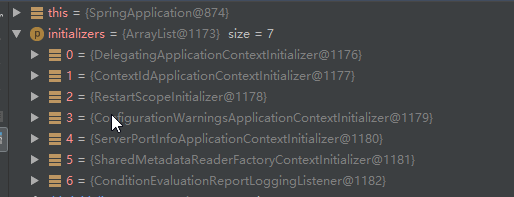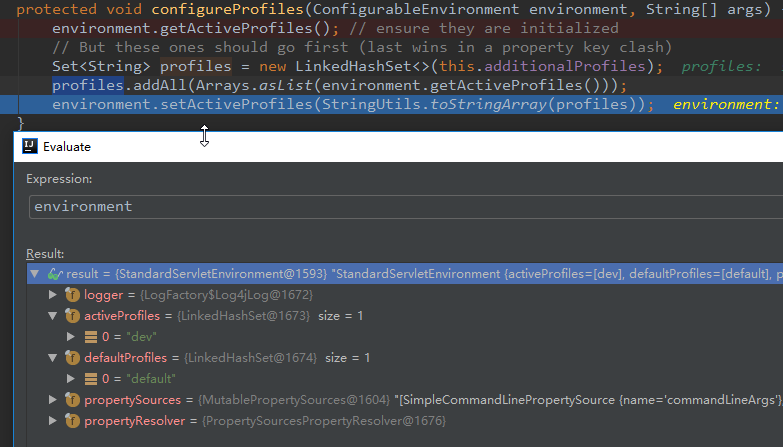Spring Boot 启动流程源码分析
学习过springboot的都知道,在Springboot的main入口函数中调用SpringApplication.run(DemoApplication.class,args)函数便可以启用SpringBoot应用程序,跟踪一下SpringApplication源码可以发现,最终还是调用了SpringApplication的动态run函数。
下面以SpringBoot2.0.3.RELEASE为例简单分析一下运行过程。
SpringApplicatiton部分源码:
1 public static ConfigurableApplicationContext run(Class<?>[] primarySources, 2 String[] args) { 3 //创建springapplication对象,调用函数run(args) 4 return new SpringApplication(primarySources).run(args); 5 }
上面的源码可以发现还是先创建SpringApplication实例,再调用run方法
第一步 分析 SpringApplication构造函数
SpringApplication构造函数代码如下:
1 public SpringApplication(ResourceLoader resourceLoader, Class<?>... primarySources) { 2 this.resourceLoader = resourceLoader; 3 Assert.notNull(primarySources, "PrimarySources must not be null"); 4 this.primarySources = new LinkedHashSet<>(Arrays.asList(primarySources)); 5 6 //1:判断web环境 7 this.webApplicationType = deduceWebApplicationType(); 8 9 //2:加载classpath下META-INF/spring.factories中配置的ApplicationContextInitializer 10 setInitializers((Collection) getSpringFactoriesInstances( 11 ApplicationContextInitializer.class)); 12 //3:加载classpath下META-INF/spring.factories中配置的ApplicationListener 13 14 setListeners((Collection) getSpringFactoriesInstances(ApplicationListener.class)); 15 //4:推断main方法所在的类 16 this.mainApplicationClass = deduceMainApplicationClass(); 17 }
具体逻辑分析:
- deduceWebApplicationType(), SpringApplication构造函数中首先初始化应用类型,根据加载相关类路径判断应用类型,具体逻辑如下:
1 private static final String REACTIVE_WEB_ENVIRONMENT_CLASS = "org.springframework." 2 + "web.reactive.DispatcherHandler"; 3 4 private static final String MVC_WEB_ENVIRONMENT_CLASS = "org.springframework." 5 + "web.servlet.DispatcherServlet"; 6 7 private static final String[] WEB_ENVIRONMENT_CLASSES = { "javax.servlet.Servlet", 8 "org.springframework.web.context.ConfigurableWebApplicationContext" }; 9 10 11 12 private WebApplicationType deduceWebApplicationType() { 13 //当类路径中存在REACTIVE_WEB_ENVIRONMENT_CLASS并且不存在MVC_WEB_ENVIRONMENT_CLASS时 14 if (ClassUtils.isPresent(REACTIVE_WEB_ENVIRONMENT_CLASS, null) 15 && !ClassUtils.isPresent(MVC_WEB_ENVIRONMENT_CLASS, null)) { 16 return WebApplicationType.REACTIVE; 17 } 18 //当加载的类路径中不包含WEB_ENVIRONMENT_CLASSES中定义的任何一个类时,返回标准应用() 19 for (String className : WEB_ENVIRONMENT_CLASSES) { 20 if (!ClassUtils.isPresent(className, null)) {
22 return WebApplicationType.NONE; 23 } 24 } 25 //加载的类路径中包含了WEB_ENVIRONMENT_CLASSES中定义的所有类型则判断为servlet的web应用 26 return WebApplicationType.SERVLET; 27 }
2. setInitializers初始化属性initializers,加载classpath下META-INF/spring.factories中配置的ApplicationContextInitializer,此处getSpringFactoriesInstances方法入参type=ApplicationContextInitializer.class
1 private <T> Collection<T> getSpringFactoriesInstances(Class<T> type, 2 Class<?>[] parameterTypes, Object... args) { 3 ClassLoader classLoader = Thread.currentThread().getContextClassLoader(); 4 // Use names and ensure unique to protect against duplicates 5 // SpringFactoriesLoader.loadFactoryNames()方法将会从calssptah下的META-INF/spring.factories中读取key为//org.springframework.context.ApplicationContextInitializer的值,并以集合形式返回 6 Set<String> names = new LinkedHashSet<>( 7 SpringFactoriesLoader.loadFactoryNames(type, classLoader)); 8 //根据返回names集合逐个实例化,也就是初始化各种ApplicationContextInitializer,这些Initializer实际是在Spring上下文ApplicationContext执行refresh前调用 9 List<T> instances = createSpringFactoriesInstances(type, parameterTypes, 10 classLoader, args, names); 11 AnnotationAwareOrderComparator.sort(instances); //对instance排序 12 return instances; 13 }
以我的demo为例,实际debug时得到的initializers如下,其中数据来源于spring-boot,spring-boot-autoconfiguration和spring-boot-devtolls三个jar包下的classpath中,ApplicationContextInitializer接口是Spring框架提供地的,其主要作用是在Spring容器初始化过程中prepareContext()这一步进行回调,具体可参考:Spring Boot(七)扩展分析

3. setListeners 初始化属性listeners,加载classpath下META-INF/spring.factories中配置的ApplicationListener,此处入参为getSpringFactoriesInstances方法入参type= ApplicationListener.class
1 private <T> Collection<T> getSpringFactoriesInstances(Class<T> type, 2 Class<?>[] parameterTypes, Object... args) { 3 ClassLoader classLoader = Thread.currentThread().getContextClassLoader(); 4 // Use names and ensure unique to protect against duplicates 5 // SpringFactoriesLoader.loadFactoryNames()方法将会从calssptah下的META-INF/spring.factories中读取key为//org.springframework.context.ApplicationListener的值,并以集合形式返回 6 Set<String> names = new LinkedHashSet<>( 7 SpringFactoriesLoader.loadFactoryNames(type, classLoader)); 8 //根据配置,初始化各种ApplicationListener,作用是用来监听ApplicationEvent 9 List<T> instances = createSpringFactoriesInstances(type, parameterTypes, 10 classLoader, args, names); 11 AnnotationAwareOrderComparator.sort(instances); 12 return instances; 13 }
第二步 分析 SpringApplication中 run方法
SpringApplication的run方法代码如下:
1 public ConfigurableApplicationContext run(String... args) { 2 StopWatch stopWatch = new StopWatch(); 3 stopWatch.start(); 4 ConfigurableApplicationContext context = null; 5 Collection<SpringBootExceptionReporter> exceptionReporters = new ArrayList<>(); 6 //设置系统变量java.awt.headless 7 configureHeadlessProperty(); 8 //1:获取监听器:加载classpath下面的META-INF/spring.factories配置的监听器SpringApplicationRunListener 9 SpringApplicationRunListeners listeners = getRunListeners(args); 10 //2:启动监听器:执行所有runlistener的starting方法,实际上发布一个【ApplicationStartingEvent】事件 11 listeners.starting(); 12 try { 13 //3:实例化ApplicationArguments对象 14 ApplicationArguments applicationArguments = new DefaultApplicationArguments( 15 args); 16 //4: 准备应用上下文环境Environment (web环境 or 标准环境)+配置Environment,主要是把run方法的参数配置到Environment 发布【ApplicationEnvironmentPreparedEvent】事件 17 ConfigurableEnvironment environment = prepareEnvironment(listeners, 18 applicationArguments); 19 configureIgnoreBeanInfo(environment); 20 //打印banner,SpringBoot启动时,控制台输出的一个歪歪扭扭的很不清楚的Spring几个大字母,也可以自定义 21 Banner printedBanner = printBanner(environment); 22 //5: 根据不同environment实例化上下文 context 23 context = createApplicationContext(); 24 // 异常处理,实例化一个SpringBootExceptionReporter.class 用于处理启动过程中的错误 25 exceptionReporters = getSpringFactoriesInstances( 26 SpringBootExceptionReporter.class, 27 new Class[] { ConfigurableApplicationContext.class }, context); 28 //6: 上下文相关预处理 发布【ApplicationPreparedEvent】事件 29 prepareContext(context, environment, listeners, applicationArguments, 30 printedBanner); 31 //7: 【刷新应用上线文】执行spring容器(context)的refresh方法,并且调用context的registerShutdownHook方法 32 refreshContext(context); 33 //8:空方法,用于扩展 34 afterRefresh(context, applicationArguments); 35 stopWatch.stop(); 36 if (this.logStartupInfo) { 37 new StartupInfoLogger(this.mainApplicationClass) 38 .logStarted(getApplicationLog(), stopWatch); 39 } 40 //9:执行所有runlisteners的started方法,发布【ApplicationStartedEvent】事件 41 listeners.started(context); 42 //10: 遍历执行CommandLineRunner和ApplicationRunner 43 //如果需要在SpringBoot应用启动后运行一些特殊的逻辑,可以通过实现ApplicationRunner或CommandLineRunner接口中的run方法,该自定义类的run方法会在此处统一调用 44 callRunners(context, applicationArguments); 45 } 46 catch (Throwable ex) { 47 handleRunFailure(context, ex, exceptionReporters, listeners); 48 throw new IllegalStateException(ex); 49 } 50 51 try { 52 listeners.running(context); 53 } 54 catch (Throwable ex) { 55 handleRunFailure(context, ex, exceptionReporters, null); 56 throw new IllegalStateException(ex); 57 } 58 return context; 59 }
具体分析:
1. 获取监听器:getRunListeners(args) 加载各种SpringApplicationRunListener实例,内部实现也还是通过SpringFactoriesLoader.loadFactoryNames(type, classLoader))实现,加载META-INF/spring.factories中key为org.springframework.boot.SpringApplicationRunListener的值,生成对应实例,SpringBoot实际加载了一个EventPublishingRunListener监听器,该监听器继承SpringApplicationRunListener接口,SpringApplicationRunListener规定了SpringBoot的生命周期,在各个生命周期广播相应的事件,调用实际的ApplicationListener类。


2. 启动监听器: listeners.starting() 执行所有SpringApplicationRunListener的stating方法,发布ApplicationStartedEvent事件,该事件被ApplicationListener类型的listener监听
3. 实例化ApplicationArguments对象
4 . 准备应用上下文环境 并发布ApplicationEnvironmentPreparedEvent事件
1 private ConfigurableEnvironment prepareEnvironment( 2 SpringApplicationRunListeners listeners, 3 ApplicationArguments applicationArguments) { 4 // Create and configure the environment 5 ConfigurableEnvironment environment = getOrCreateEnvironment(); 6 //根据properties和profiles配置环境 7 configureEnvironment(environment, applicationArguments.getSourceArgs()); 8 // 执行EventPublishingRunListener发布ApplicationEnvironmentPreparedEvent事件,将会被ApplicationListener监听到 9 listeners.environmentPrepared(environment); 10 // 11 bindToSpringApplication(environment); 12 if (this.webApplicationType == WebApplicationType.NONE) { 13 environment = new EnvironmentConverter(getClassLoader()) 14 .convertToStandardEnvironmentIfNecessary(environment); 15 } 16 ConfigurationPropertySources.attach(environment); 17 return environment; 18 }
备注:实际上载spring-boot-2.0.3.RELEASE.jar包中,可以发现spring.factories中只配置了一个RunListener: org.springframework.boot.context.event.EventPublishingRunListener
截取EventPublishingRunListener.java部分代码:
1 public class EventPublishingRunListener implements SpringApplicationRunListener, Ordered { 2 3 4 public EventPublishingRunListener(SpringApplication application, String[] args) { 5 this.application = application; 6 this.args = args; 7 this.initialMulticaster = new SimpleApplicationEventMulticaster(); 8 //将SpringApplication实例中的ApplicationListener类型的listeners添加到initialMulticaster,后续执行监听 9 for (ApplicationListener<?> listener : application.getListeners()) { 10 this.initialMulticaster.addApplicationListener(listener); 11 } 12 } 13 14 // 发布一个ApplicationEnvironmentPreparedEvent事件 15 @Override 16 public void environmentPrepared(ConfigurableEnvironment environment) { 17 //所有被添加到initialMulticaster中的listener都将监听ApplicationEnvironmentPreparedEvent事件 18 this.initialMulticaster.multicastEvent(new ApplicationEnvironmentPreparedEvent( 19 this.application, this.args, environment)); 20 } 21 22 }
4.1 根据properties和profiles配置环境:configureEnvironment(environment, applicationArguments.getSourceArgs());
以下假设指定配文件application-dev.properties,跟踪一下源码,可以发现:
protected void configureEnvironment(ConfigurableEnvironment environment, String[] args) { configurePropertySources(environment, args); configureProfiles(environment, args); }
configureEnvironment方法内部比较简洁,直接调用两个方法完事,
configurePropertySources(environment, args)方法的作用是将args封装成了SimpleCommandLinePropertySource并加入到了environment中,其中arg中含有启动参数:--spring.profiles.active=dev
configureProfiles(environment, args)作用是将启动参数中指定的配置文件激活。



configureProfiles中执行enviroment.getActiveProfiles():强制读取启动命令中指定的配置文件
protected Set<String> doGetActiveProfiles() { synchronized (this.activeProfiles) { if (this.activeProfiles.isEmpty()) { String profiles = getProperty(ACTIVE_PROFILES_PROPERTY_NAME); if (StringUtils.hasText(profiles)) { setActiveProfiles(StringUtils.commaDelimitedListToStringArray( StringUtils.trimAllWhitespace(profiles))); } } return this.activeProfiles; } }
5. 根据environment类型创建ApplicationContext,通常情况下,我们启动的是一个Servlet应用,debug进createApplicationContext()源码,可以看到内部初始化了AnnotationConfigServletWebServerApplicationContext类,也就是我们的上下文context
6. 上下文相关预处理,prepareContext()方法
1 private void prepareContext(ConfigurableApplicationContext context, 2 ConfigurableEnvironment environment, SpringApplicationRunListeners listeners, 3 ApplicationArguments applicationArguments, Banner printedBanner) { 4 context.setEnvironment(environment); //设置容器环境,environment前面已经准备好 5 //配置beanNameGenerator和资源加载器 6 postProcessApplicationContext(context); 7 //回调所有的ApplicationContextInitializer初始化器 8 applyInitializers(context); 9 //发布容器以准备好的事件:执行所有SpringApplicationRunListener的contextPrepared方法,触发事件,实际上EventPublishingRunListener中contextPrepared是一个空方法,什么都没执行 10 listeners.contextPrepared(context); 11 if (this.logStartupInfo) { 12 logStartupInfo(context.getParent() == null); 13 logStartupProfileInfo(context); 14 } 15 16 //向Spring容器注入springApplicationArguments和springBootBanner,实际执行是将main函数的参数args和printedBanner分别封装成单例bean注册到容器中。 17 // Add boot specific singleton beans 18 context.getBeanFactory().registerSingleton("springApplicationArguments", 19 applicationArguments); 20 if (printedBanner != null) { 21 context.getBeanFactory().registerSingleton("springBootBanner", printedBanner); 22 } 23 24 // Load the sources 25 Set<Object> sources = getAllSources(); 26 Assert.notEmpty(sources, "Sources must not be empty");
//加载启动类,将启动类也注入容器 27 load(context, sources.toArray(new Object[0])); 28 //发布容器已加载事件:执行所有SpringApplicationRunListener的contextLoaded方法,下面是EventPublishingRunListener中的contextLoaded 29 listeners.contextLoaded(context); 30 }
具体load方法实现, load方法的作用其注释写的也很清楚,"Load beans into the application context",实际执行时可以发现主要是将我们的SpringBoot应用的启动类(此处SpringbootdemoApplication2)注册到容器中!前面if条件都为false,不执行,具体分析loader.loader()。
protected void load(ApplicationContext context, Object[] sources) { if (logger.isDebugEnabled()) { logger.debug( "Loading source " + StringUtils.arrayToCommaDelimitedString(sources)); } BeanDefinitionLoader loader = createBeanDefinitionLoader( getBeanDefinitionRegistry(context), sources); if (this.beanNameGenerator != null) { loader.setBeanNameGenerator(this.beanNameGenerator); } if (this.resourceLoader != null) { loader.setResourceLoader(this.resourceLoader); } if (this.environment != null) { loader.setEnvironment(this.environment); } loader.load(); }
loader.load()源码:
public int load() { int count = 0; for (Object source : this.sources) { count += load(source); } return count; } private int load(Object source) { Assert.notNull(source, "Source must not be null"); if (source instanceof Class<?>) { return load((Class<?>) source); //执行 } if (source instanceof Resource) { return load((Resource) source); } if (source instanceof Package) { return load((Package) source); } if (source instanceof CharSequence) { return load((CharSequence) source); } throw new IllegalArgumentException("Invalid source type " + source.getClass()); } private int load(Class<?> source) { if (isGroovyPresent() && GroovyBeanDefinitionSource.class.isAssignableFrom(source)) { // Any GroovyLoaders added in beans{} DSL can contribute beans here GroovyBeanDefinitionSource loader = BeanUtils.instantiateClass(source, GroovyBeanDefinitionSource.class); load(loader); } if (isComponent(source)) { this.annotatedReader.register(source); return 1; } return 0; }
isComponent(source)方法判断当前类是不是有@Component注解,显然启动类的@SpringBootApplication这个组合注解是包含Component注解的。
this.annotatedReader.register(source)方法内部调用Spring框架底层提供的AnnotatedBeanDefinitionReader.doRegisterBean(xxx)方法,最终将SpringBoot应用的启动类注册到容器中。

7. 执行context的refresh,并且调用context的registerShutdownHook方法,refresh方法的具体逻辑分析可以参考:
Spring源码解析 – AnnotationConfigApplicationContext容器创建过程
8. afterRefresh空方法
9. 执行所有runlisteners的started方法,发布ApplicationStartedEvent事件
10. 遍历执行CommandLineRunner和ApplicationRunner
以上。


 浙公网安备 33010602011771号
浙公网安备 33010602011771号